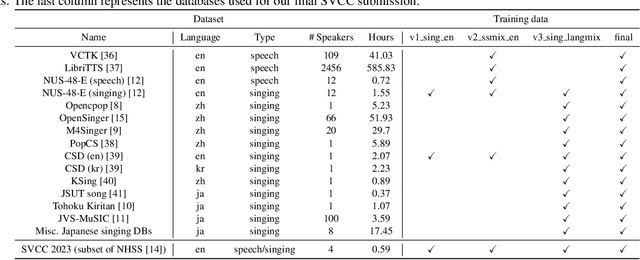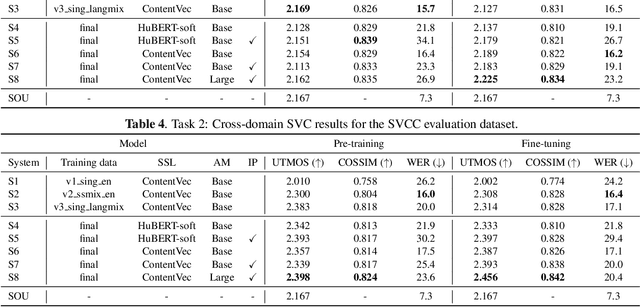Wen-Chin Huang
The Singing Voice Conversion Challenge 2025: From Singer Identity Conversion To Singing Style Conversion
Sep 19, 2025Abstract:We present the findings of the latest iteration of the Singing Voice Conversion Challenge, a scientific event aiming to compare and understand different voice conversion systems in a controlled environment. Compared to previous iterations which solely focused on converting the singer identity, this year we also focused on converting the singing style of the singer. To create a controlled environment and thorough evaluations, we developed a new challenge database, introduced two tasks, open-sourced baselines, and conducted large-scale crowd-sourced listening tests and objective evaluations. The challenge was ran for two months and in total we evaluated 26 different systems. The results of the large-scale crowd-sourced listening test showed that top systems had comparable singer identity scores to ground truth samples. However, modeling the singing style and consequently achieving high naturalness still remains a challenge in this task, primarily due to the difficulty in modeling dynamic information in breathy, glissando, and vibrato singing styles.
Advancing Speech Quality Assessment Through Scientific Challenges and Open-source Activities
Aug 01, 2025Abstract:Speech quality assessment (SQA) refers to the evaluation of speech quality, and developing an accurate automatic SQA method that reflects human perception has become increasingly important, in order to keep up with the generative AI boom. In recent years, SQA has progressed to a point that researchers started to faithfully use automatic SQA in research papers as a rigorous measurement of goodness for speech generation systems. We believe that the scientific challenges and open-source activities of late have stimulated the growth in this field. In this paper, we review recent challenges as well as open-source implementations and toolkits for SQA, and highlight the importance of maintaining such activities to facilitate the development of not only SQA itself but also generative AI for speech.
SHEET: A Multi-purpose Open-source Speech Human Evaluation Estimation Toolkit
May 21, 2025Abstract:We introduce SHEET, a multi-purpose open-source toolkit designed to accelerate subjective speech quality assessment (SSQA) research. SHEET stands for the Speech Human Evaluation Estimation Toolkit, which focuses on data-driven deep neural network-based models trained to predict human-labeled quality scores of speech samples. SHEET provides comprehensive training and evaluation scripts, multi-dataset and multi-model support, as well as pre-trained models accessible via Torch Hub and HuggingFace Spaces. To demonstrate its capabilities, we re-evaluated SSL-MOS, a speech self-supervised learning (SSL)-based SSQA model widely used in recent scientific papers, on an extensive list of speech SSL models. Experiments were conducted on two representative SSQA datasets named BVCC and NISQA, and we identified the optimal speech SSL model, whose performance surpassed the original SSL-MOS implementation and was comparable to state-of-the-art methods.
Serenade: A Singing Style Conversion Framework Based On Audio Infilling
Mar 16, 2025Abstract:We propose Serenade, a novel framework for the singing style conversion (SSC) task. Although singer identity conversion has made great strides in the previous years, converting the singing style of a singer has been an unexplored research area. We find three main challenges in SSC: modeling the target style, disentangling source style, and retaining the source melody. To model the target singing style, we use an audio infilling task by predicting a masked segment of the target mel-spectrogram with a flow-matching model using the complement of the masked target mel-spectrogram along with disentangled acoustic features. On the other hand, to disentangle the source singing style, we use a cyclic training approach, where we use synthetic converted samples as source inputs and reconstruct the original source mel-spectrogram as a target. Finally, to retain the source melody better, we investigate a post-processing module using a source-filter-based vocoder and resynthesize the converted waveforms using the original F0 patterns. Our results showed that the Serenade framework can handle generalized SSC tasks with the best overall similarity score, especially in modeling breathy and mixed singing styles. Moreover, although resynthesizing with the original F0 patterns alleviated out-of-tune singing and improved naturalness, we found a slight tradeoff in similarity due to not changing the F0 patterns into the target style.
MOS-Bench: Benchmarking Generalization Abilities of Subjective Speech Quality Assessment Models
Nov 06, 2024Abstract:Subjective speech quality assessment (SSQA) is critical for evaluating speech samples as perceived by human listeners. While model-based SSQA has enjoyed great success thanks to the development of deep neural networks (DNNs), generalization remains a key challenge, especially for unseen, out-of-domain data. To benchmark the generalization abilities of SSQA models, we present MOS-Bench, a diverse collection of datasets. In addition, we also introduce SHEET, an open-source toolkit containing complete recipes to conduct SSQA experiments. We provided benchmark results for MOS-Bench, and we also explored multi-dataset training to enhance generalization. Additionally, we proposed a new performance metric, best score difference/ratio, and used latent space visualizations to explain model behavior, offering valuable insights for future research.
The VoiceMOS Challenge 2024: Beyond Speech Quality Prediction
Sep 11, 2024



Abstract:We present the third edition of the VoiceMOS Challenge, a scientific initiative designed to advance research into automatic prediction of human speech ratings. There were three tracks. The first track was on predicting the quality of ``zoomed-in'' high-quality samples from speech synthesis systems. The second track was to predict ratings of samples from singing voice synthesis and voice conversion with a large variety of systems, listeners, and languages. The third track was semi-supervised quality prediction for noisy, clean, and enhanced speech, where a very small amount of labeled training data was provided. Among the eight teams from both academia and industry, we found that many were able to outperform the baseline systems. Successful techniques included retrieval-based methods and the use of non-self-supervised representations like spectrograms and pitch histograms. These results showed that the challenge has advanced the field of subjective speech rating prediction.
Quantifying the effect of speech pathology on automatic and human speaker verification
Jun 10, 2024



Abstract:This study investigates how surgical intervention for speech pathology (specifically, as a result of oral cancer surgery) impacts the performance of an automatic speaker verification (ASV) system. Using two recently collected Dutch datasets with parallel pre and post-surgery audio from the same speaker, NKI-OC-VC and SPOKE, we assess the extent to which speech pathology influences ASV performance, and whether objective/subjective measures of speech severity are correlated with the performance. Finally, we carry out a perceptual study to compare judgements of ASV and human listeners. Our findings reveal that pathological speech negatively affects ASV performance, and the severity of the speech is negatively correlated with the performance. There is a moderate agreement in perceptual and objective scores of speaker similarity and severity, however, we could not clearly establish in the perceptual study, whether the same phenomenon also exists in human perception.
Multi-speaker Text-to-speech Training with Speaker Anonymized Data
May 20, 2024Abstract:The trend of scaling up speech generation models poses a threat of biometric information leakage of the identities of the voices in the training data, raising privacy and security concerns. In this paper, we investigate training multi-speaker text-to-speech (TTS) models using data that underwent speaker anonymization (SA), a process that tends to hide the speaker identity of the input speech while maintaining other attributes. Two signal processing-based and three deep neural network-based SA methods were used to anonymize VCTK, a multi-speaker TTS dataset, which is further used to train an end-to-end TTS model, VITS, to perform unseen speaker TTS during the testing phase. We conducted extensive objective and subjective experiments to evaluate the anonymized training data, as well as the performance of the downstream TTS model trained using those data. Importantly, we found that UTMOS, a data-driven subjective rating predictor model, and GVD, a metric that measures the gain of voice distinctiveness, are good indicators of the downstream TTS performance. We summarize insights in the hope of helping future researchers determine the goodness of the SA system for multi-speaker TTS training.
A Large-Scale Evaluation of Speech Foundation Models
Apr 15, 2024Abstract:The foundation model paradigm leverages a shared foundation model to achieve state-of-the-art (SOTA) performance for various tasks, requiring minimal downstream-specific modeling and data annotation. This approach has proven crucial in the field of Natural Language Processing (NLP). However, the speech processing community lacks a similar setup to explore the paradigm systematically. In this work, we establish the Speech processing Universal PERformance Benchmark (SUPERB) to study the effectiveness of the paradigm for speech. We propose a unified multi-tasking framework to address speech processing tasks in SUPERB using a frozen foundation model followed by task-specialized, lightweight prediction heads. Combining our results with community submissions, we verify that the foundation model paradigm is promising for speech, and our multi-tasking framework is simple yet effective, as the best-performing foundation model shows competitive generalizability across most SUPERB tasks. For reproducibility and extensibility, we have developed a long-term maintained platform that enables deterministic benchmarking, allows for result sharing via an online leaderboard, and promotes collaboration through a community-driven benchmark database to support new development cycles. Finally, we conduct a series of analyses to offer an in-depth understanding of SUPERB and speech foundation models, including information flows across tasks inside the models, the correctness of the weighted-sum benchmarking protocol and the statistical significance and robustness of the benchmark.
A Comparative Study of Voice Conversion Models with Large-Scale Speech and Singing Data: The T13 Systems for the Singing Voice Conversion Challenge 2023
Oct 08, 2023



Abstract:This paper presents our systems (denoted as T13) for the singing voice conversion challenge (SVCC) 2023. For both in-domain and cross-domain English singing voice conversion (SVC) tasks (Task 1 and Task 2), we adopt a recognition-synthesis approach with self-supervised learning-based representation. To achieve data-efficient SVC with a limited amount of target singer/speaker's data (150 to 160 utterances for SVCC 2023), we first train a diffusion-based any-to-any voice conversion model using publicly available large-scale 750 hours of speech and singing data. Then, we finetune the model for each target singer/speaker of Task 1 and Task 2. Large-scale listening tests conducted by SVCC 2023 show that our T13 system achieves competitive naturalness and speaker similarity for the harder cross-domain SVC (Task 2), which implies the generalization ability of our proposed method. Our objective evaluation results show that using large datasets is particularly beneficial for cross-domain SVC.
 Add to Chrome
Add to Chrome Add to Firefox
Add to Firefox Add to Edge
Add to Edge